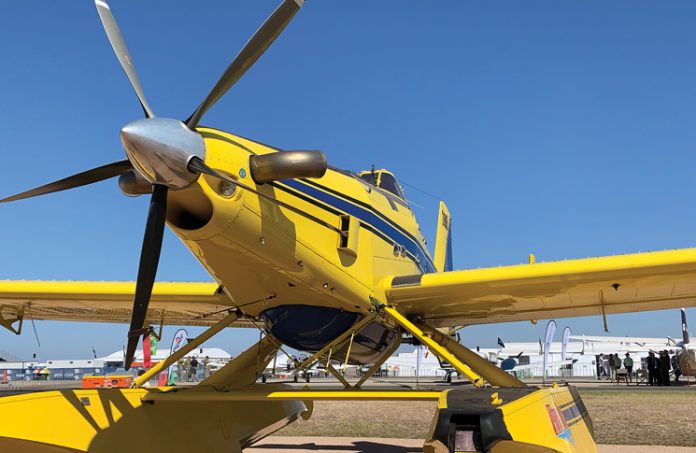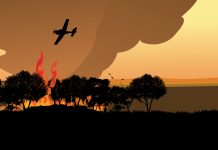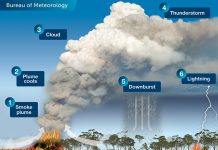Coordinating firefighting aircraft is a complex juggling act of safety-critical decisions, played out in heat and smoke
Pick your analogy: a bushfire fighting air attack supervisor is either the civilian equivalent of a senior military officer in the heat of battle (not quite a general, because the air attack supervisor is on the battlefield rather than safely away from the front) or a ringmaster in a three-ring (or more) flying circus that performs its trapeze and highwire acts for ever-longer seasons.
‘We used to have 3 months on and 9 months off but, in 2019–20, there was only a five-month gap in the season,’ says Ivan Perkins, an air attack supervisor who has been with the NSW Rural Fire Service for 17 years. His role is coordinator in an aircraft circling above bushfires, guiding aerial firefighting activity – water and retardant drops by helicopters and fixed-wing aircraft including large air tankers.
He has been working in aviation firefighting since 2007, completing his training as an air attack supervisor in 2012.
In the horrendous 2019–20 fire season, Perkins spent 350 hours in the air, fighting fires in Queensland and NSW. That ‘black summer’ was his seventh in the role.
That big-picture view is critical, taking a strategic approach to fighting the fire.
By contrast, for Nadia Rhodes, a ranger with ACT Parks and Conservation, 2019–20 was literally a baptism of fire, her first season as a supervisor. She had experience with ground firefighting as a ranger and some experience as an aerial observer. ‘After I did my [air attack supervisor] training, I was hoping to gain experience slowly,’ she says. However, that season began by being ‘thrown in at the deep end’.
‘It was a steep learning curve,’ she says. ‘I went to Glen Innes, an area I’m not familiar with, with people I’m not familiar with, and vegetation I was not familiar with.’
Infernal chief officers: the air attack supervisor’s role
The National Aerial Firefighting Centre’s submission to the 2020 Bushfires Royal Commission described the role: ‘The air attack supervisor directs the tactics that the pilot of the aircraft is to employ when attacking the bushfire, in accordance with the objectives of the Incident Action Plan … these roles are harder to source than general incident management roles, owing to the increased training and currency requirements for these safety-critical roles.’
Perkins says, ‘People tend to think what we do is just putting the wet stuff on the hot stuff.’ Not surprisingly, there’s a lot more to it than that. Others have described the role of the air attack supervisor as being more like mobile air traffic control. Neither is accurate.
Rhodes says the supervisor role carries a huge responsibility. ‘You have to understand fire behaviour – where the fire is going – let people know about the fire area, the resources needed – ground or aircraft – line up water drops and assets,’ she says. ‘You need to be able to think ahead of the fire’.
Perkins says that big-picture view is critical to taking a strategic approach to fighting the fire. ‘Sometimes, you have to pull back from the fire and say to yourself, “maybe I don’t need this air show, maybe we should let this fire burn out to containment lines”,’ he says. ‘There’s a lot to manage – not just trying to maintain comms with a number of aircraft, but comms with the ground crew.’
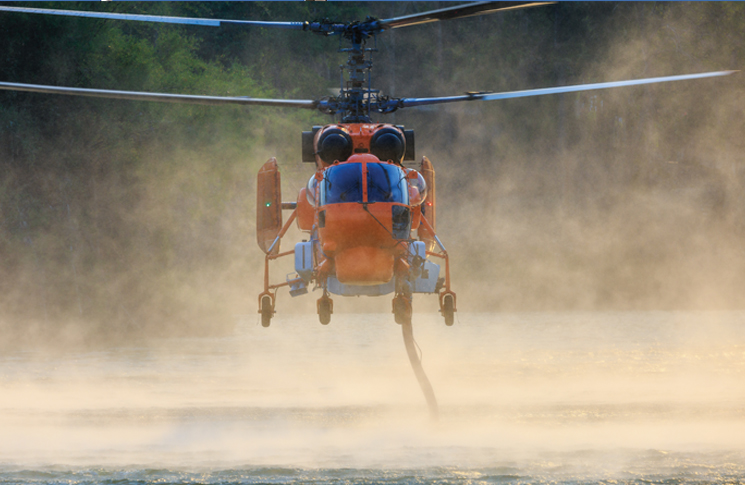
Rhodes says, ‘You’re listening into several different aircraft channels and listening into the ground crew, hearing all the comms. Then you have to filter out what needs attention.’
On his busiest days during the 2019–20 season, Perkins was coordinating up to a dozen aircraft, a mix of light and medium rotary and fixed-wing machines. Some were ‘Fire Bosses’, Air Tractors fitted with floats that can scoop up water. Others were unmodified Air Tractors which landed at airports to refill water tanks.
‘You have to set up the pattern so it runs seamlessly,’ Perkins says.
For example, at the NSW North Coast fires, the Fire Bosses were going from the fire to the scoop site at a creek near Yamba in a 5-minute turnaround, whereas the turnaround for the
Air Tractors to refill at Grafton was 15 minutes.
Ray Cronin, CEO of Kestrel Aviation and president of the Australian Helicopter Industry Association, says aerial firefighting is an increasingly dynamic environment. There is the changing fire behaviour seen in the 2019–20 season, with the intensity and duration of bushfires, the prevalence of challenging pyrocumulonimbus cloud formations, along with the increasingly complex mix of aircraft used to fight them.
On his busiest days during the 2019–20 season, Perkins was coordinating up to a dozen aircraft.
‘I don’t envy them their task – at times it’s not possible to look out for everything,’ he says. ‘While it’s the air attack pilot’s responsibility to keep their platforms safe, the supervisor is very much in the hot seat. It’s not a comfortable environment – it’s hot, bumpy at lower levels and you put in long hours.’
That’s where crew resource management (CRM) comes in. ‘At 1000 feet, an experienced pilot won’t be that loaded up, so they can handle radio comms for the supervisor,’ Cronin says.
Perkins agrees. ‘When you’re under a high workload in the cockpit, CRM is huge,’ he says. ‘On the ground as well, with loaders and firefighters. You’re part of a team and of a network – the moment you start to do it in isolation, you’ll fail.’
He says an experienced pilot will sometimes anticipate the supervisor and deliver on their intent, relieving some of the workload.
However, Cronin says it is wrong to think of the role of the air attack supervisor as a pseudo air traffic controller, and the supervisor shouldn’t be adopting that role. ‘They don’t have the equipment to back them up,’ he says. ‘In a smoky environment, someone could give their location where they think they are, but they could be on the other side of the hill. There’s a danger in giving a separation role to the supervisor.’
The most important point is that the combination of good communication and the supervisor’s position as an eye in the sky gives everyone a high-level awareness of what’s going on.
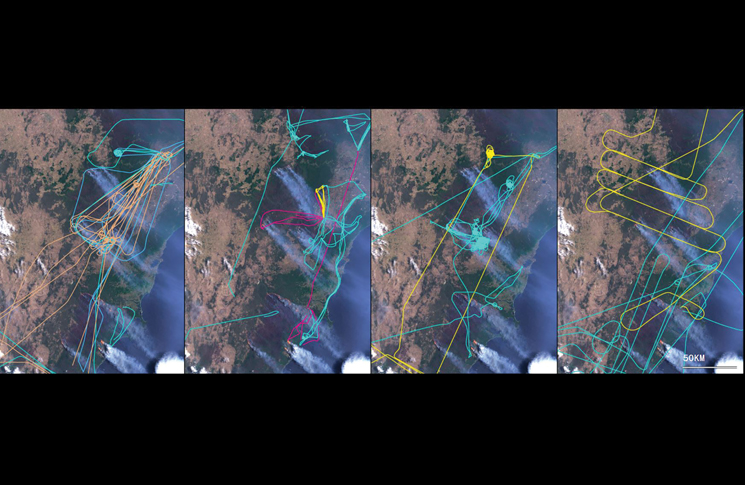
Cool hand: characteristics of a good air attack supervisor
The supervisor must have a good understanding and experience of on-the-ground firefighting. That is assumed, Perkins says. ‘Firefighting is in my blood.’ He joined the NSW Rural Fire Service as a volunteer in 1997 and joined the service full-time in 2004.
‘If you’re highly strung, then being a supervisor is not the job for you,’ he says. ‘You have
to be calm, but firm in command.’ He worries about younger people with limited life experience performing the role. ‘You need a certain amount of life maturity, otherwise you risk being manipulated.’
A good air attack supervisor must find the balance between being prepared to take responsibility for making split-second decisions and working collaboratively as part of a team. ‘It can be quite confronting, choosing what burns and what doesn’t, picking which area has a better chance of being controlled by firefighters,’ Rhodes says.
Cronin points out there are many distractions for aerial firefighters. ‘It is all about keeping the picture together all the time without losing it,’ he says.
Perkins says the supervisor must be good at logistics and planning. ‘It’s not just about reacting,’ he says. For the most efficient use of the various assets available, the supervisor must know their capabilities and performance characteristics.
‘For example, the large air tankers are ultimately a great pre-planning tool,’ he says. ‘If you know the major impact of a fire is coming over the next few days, you use the tankers in those days of clear air to lay retardant lines. That way, you don’t have to integrate them into your traffic as much and have to clear airspace for them because they are so large.
‘On the days when we have bad fire weather, aircraft are being used more frequently for first dispatch along with ground crews for initial attack, to keep the fire as small as possible. Doing this, limiting the fire’s spread and intensity, gives a better chance of controlling the fire. Traditionally, aircraft aren’t brought in until fires become larger and more difficult to control. The challenge is balancing the number of aircraft committed to fighting existing fires with those committed to standby for new fires.
‘The Erickson [Aircrane] is great as an interface in property protection, but you have to weigh up its 90-minute fuel cycle against the belly-tank flexibility of the Bell 212 and 412s – maybe it’s better to use two mediums.’
Into the mix: more aircraft types
The National Aerial Firefighting Centre contracted 160 aircraft of 32 types on behalf of state and territory governments for the 2019–20 firefighting season. Adding state-owned, state-contracted and private operators meant 200 operators were operating a fleet of 500 aircraft.
The aircraft ranged from light helicopters such as the small, composite single-engine
Eurocopter EC120B Colibri, to the large fixed-wing DC-10 air tanker. The EC120B is used mainly for air attack supervision and gathering information about the fire to relay to the incident management team, whereas the DC-10’s 35,600 litre fire retardant capacity is used to create containment lines.
Simulated chaos: new training methods
In its 579-page report released in October 2020, the Bushfires Royal Commission acknowledged the changing role of the supervisor.
‘All agencies note the need for an escalating structure for air attack supervisor roles that takes into account the more advanced skill levels required for:
- supervision of type 1 aircraft (heavy helicopters, such as the Erickson Aircrane)
- supervision of large air tankers
- supervision of complex operation in terms of the number of aircraft supervised or risk.’
The report said agencies were divided on the best approach but they recognised the need to refine supervisor training.
For example, the NSW RFS opened a state-of-the-art training academy at Dubbo this year. The first trainees had 2 sessions with a new simulator to practise air attack supervision in a mock aircraft and develop communication skills.
Perkins, who was unable to attend a scheduled session in August because of the pandemic lockdown, says the simulator helps to familiarise trainees with procedures. ‘Traditional training involves a week of theory and then flights, but if you don’t get it, you can’t go back and do it again,’ he says.
The simulator allows for repetition of training scenarios and for new trainees to see whether they’re suitable by teasing out their planning ability and crew resource management skills. ‘Simulators can’t replace in-air live training,’ he says. However, they can screen new recruits for suitability and refresh the skills of experienced supervisors.

